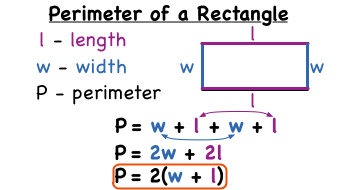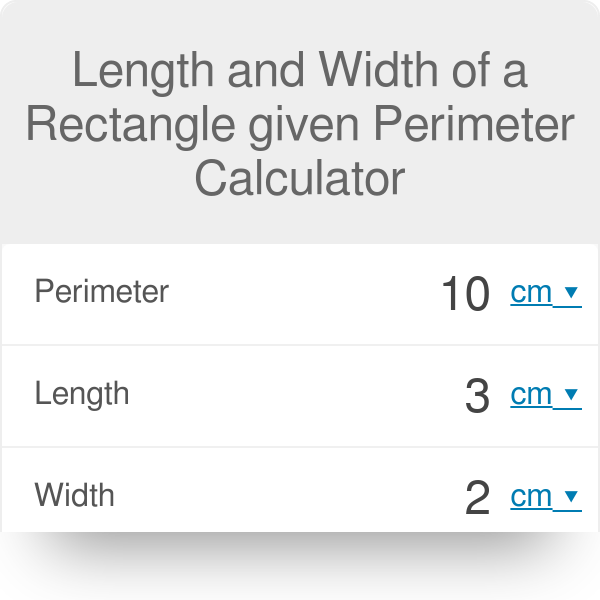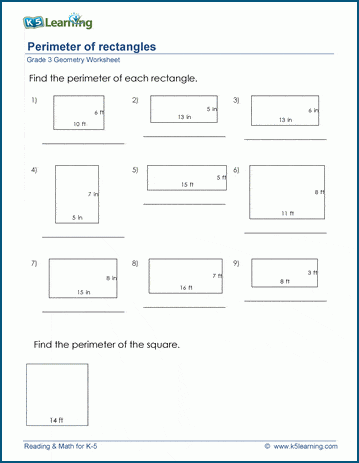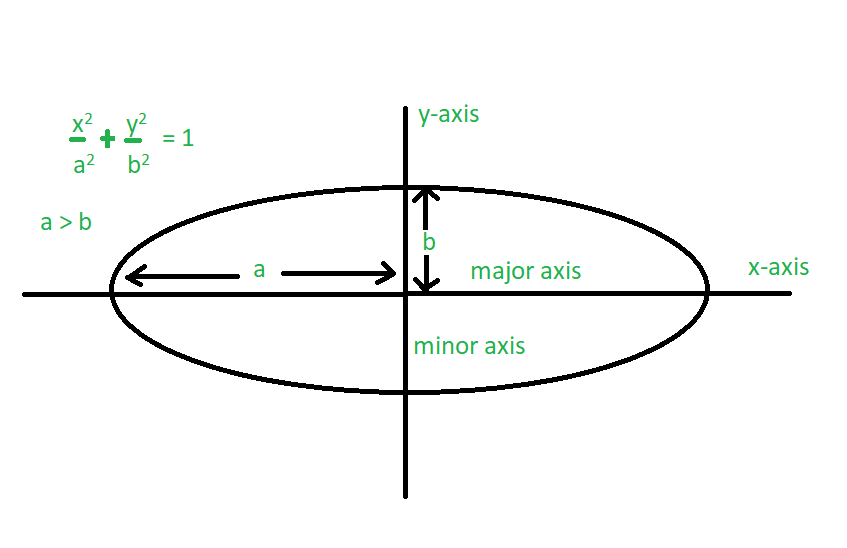Topic how to find length and width from perimeter: Discover the art of geometry as we delve into methods for finding length and width from a given perimeter, simplifying complex calculations and opening new dimensions of understanding in everyday shapes.
Table of Content
- Understanding the Perimeter of a Rectangle
- YOUTUBE: How to Find the Length and Width of a Rectangle with the Perimeter
- Basic Formulas for Rectangle Perimeter and Dimensions
- Steps to Calculate Length or Width from Known Perimeter
- Example Problems and Solutions
- Applications in Real-Life Scenarios
- Using Online Calculators and Tools
- Understanding Measurements: Length, Width, and Perimeter
- Practical Tips for Accurate Measurement
- Advanced Concepts: Relationship Between Area and Perimeter
- Interactive Practice Problems and Quizzes
Understanding the Perimeter of a Rectangle
The perimeter of a rectangle is the total distance around its boundary. It\"s calculated by adding the lengths of all four sides. Since a rectangle has two pairs of equal opposite sides, its perimeter formula simplifies to P = 2(L + W), where P is the perimeter, L is the length, and W is the width.
Key concepts to understand include:
- Equal Opposite Sides: In a rectangle, opposite sides are equal in length. This is crucial for calculating the perimeter.
- Perimeter Formula: The formula P = 2(L + W) represents the total distance around the rectangle, calculated by doubling the sum of its length and width.
- Units of Measurement: Consistency in units (meters, feet, inches, etc.) is essential for accurate calculation.
- Solving for One Dimension: If the perimeter and one dimension (either length or width) are known, the other can be determined. For example, if P and L are known, W can be calculated as W = (P/2) - L.
Understanding these principles is fundamental for solving problems related to the dimensions of a rectangle when given its perimeter. This knowledge has practical applications in fields such as architecture, design, and everyday problem-solving.

READ MORE:
How to Find the Length and Width of a Rectangle with the Perimeter
1.Rectangle: \"Discover the fascinating world of rectangles in our mesmerizing video that showcases their symmetry, versatility, and uncanny ability to create stunning geometric patterns. Don\'t miss out on this captivating visual journey!\" 2.Measure: \"Unlock the secrets of accurate measurement with our informative video that simplifies complex measuring techniques. Learn how to effortlessly measure objects of all shapes and sizes, and elevate your precision skills to the next level.\" 3.Math: \"Fall in love with the magic of mathematics as you dive into our captivating video that explores the incredible power and beauty of numbers. Witness how math can solve complex problems, unlock new possibilities, and reshape the way you see the world.\"
How to Measure Length and Width with Perimeter Information
How to Measure Length and Width When Knowing the Perimeter. Part of the series: Algebra Tips. So long as you\'re given the ...
Basic Formulas for Rectangle Perimeter and Dimensions
Understanding the basic formulas for calculating the perimeter and dimensions of a rectangle is essential for solving various geometric problems. The perimeter of a rectangle is the total distance around its edge, and it\"s given by the formula:
- Perimeter Formula: P = 2(L + W), where P represents the perimeter, L is the length, and W is the width of the rectangle.
This formula is derived from the fact that a rectangle has two pairs of equal sides. To solve for either the length or the width if the other dimension and the perimeter are known, the formula can be rearranged:
- To find the length (L), use the formula: L = (P/2) - W.
- To find the width (W), use the formula: W = (P/2) - L.
These formulas are particularly useful in various practical applications, such as construction, crafting, and more, where the dimensions of rectangular shapes are involved.

How to Find Length and Width with Perimeter and Square Area: Math Skills
Subscribe Now: http://www.youtube.com/subscription_center?add_user=ehoweducation Watch More: ...
Steps to Calculate Length or Width from Known Perimeter
To calculate the length or width of a rectangle from its known perimeter, follow these systematic steps:
- Identify the Known Values: Determine the perimeter (P) of the rectangle and the measurement of either the length (L) or the width (W) that is already known.
- Use the Perimeter Formula: Recall the basic perimeter formula for a rectangle, P = 2(L + W).
- Rearrange the Formula: To find the unknown dimension, rearrange the formula. If the length is unknown, use L = (P/2) - W. If the width is unknown, use W = (P/2) - L.
- Substitute the Known Values: Insert the known perimeter and one dimension (either length or width) into the rearranged formula.
- Calculate: Perform the calculation to find the unknown dimension (length or width).
- Verify Units: Ensure that the units of your answer match the units used for the input values.
This method is a straightforward approach to deduce one missing dimension of a rectangle when its perimeter and the other dimension are known.

Example Problems and Solutions
Understanding how to apply formulas to real-life scenarios is crucial. Here are some example problems with solutions:
- Example 1: If the perimeter of a rectangle is 20 meters and the width is 4 meters, find the length.
- Solution: Use the formula L = (P/2) - W.
- P = 20 meters, W = 4 meters.
- L = (20/2) - 4 = 10 - 4 = 6 meters.
- Therefore, the length is 6 meters.
- Example 2: Find the width of a rectangle whose perimeter is 30 cm and length is 9 cm.
- Solution: Apply the formula W = (P/2) - L.
- P = 30 cm, L = 9 cm.
- W = (30/2) - 9 = 15 - 9 = 6 cm.
- The width is 6 cm.
- Example 3: A rectangular garden has a perimeter of 40 meters. If the width is 7 meters, what is the length?
- Solution: Use L = (P/2) - W.
- P = 40 meters, W = 7 meters.
- L = (40/2) - 7 = 20 - 7 = 13 meters.
- The length of the garden is 13 meters.
These examples illustrate how to use the perimeter formula to find either the length or width of a rectangle, which is a common problem in geometry.

Applications in Real-Life Scenarios
Understanding the perimeter of different shapes and structures has practical applications in various real-life scenarios. These applications range from everyday tasks to specialized fields, demonstrating the fundamental role of perimeter calculations in our lives.
- Measuring Fields and Land: Farmers often calculate the perimeter of their land for tasks such as fencing and plotting crops. This also helps in safeguarding the farm from wild animals.
- Construction of Buildings and Homes: In construction, the perimeter plays a vital role in determining the geometrical aspects of buildings, both commercial and residential. It helps in planning the layout and allocation of space.
- Material Requirement in Construction: When constructing additional structures like cabins or fences, the perimeter calculation is crucial for determining the amount of material required.
- Computer-Aided Graphic Design: The perimeter is extensively used in graphic design for creating accurate graphics, shapes, and characters, particularly in the gaming industry for designing characters and environments.
- Fashion and Art: In fashion, the perimeter is used for cutting fabrics in apparel design. In art, it assists in precise measurements for sketching and painting.
- Astronomy: Perimeter calculations are significant in astronomy for measuring the orbits and movements of planets within our solar system.
- Gardening and Landscaping: Calculating the perimeter is essential for building fences around gardens to protect them from pests and to determine the amount of fencing material needed.
- Interior Design and Decoration: The perimeter assists in estimating the quantity of materials like paint, wallpaper, or molding needed for decorating and finishing rooms.
- Sports Facilities: For sports tracks and fields, perimeter measurement is crucial to ensure accurate dimensions for training and competition purposes.
- Surveying and Property Management: Surveyors use perimeter measurements to define property boundaries and calculate fencing requirements for land parcels.
These examples illustrate the diverse and essential nature of perimeter calculations in a wide array of real-life applications, emphasizing the importance of understanding these concepts.

_HOOK_
Using Online Calculators and Tools
Online calculators and tools offer a convenient way to find the length and width of a rectangle from its perimeter. These tools use standard geometric formulas to calculate dimensions accurately and quickly.
Steps to Use Online Rectangle Calculators
- Input Data: Enter the known values of the rectangle\"s perimeter and, if available, its area into the calculator.
- Choose the Calculation: Select whether you want to calculate the length, width, or both. Some calculators may also offer to calculate the diagonal.
- Perform the Calculation: The calculator processes the input values using formulas like (P = 2 imes L + 2 imes W) for perimeter and (A = L imes W) for area, where (P) is the perimeter, (A) is the area, (L) is the length, and (W) is the width.
- Interpret the Results: The output will provide the calculated dimensions of the rectangle. Some tools might also show the diagonal measurement.
Additional Features of Online Calculators
- Some calculators allow conversions between different units of measurement.
- Advanced calculators may offer graphical representations or sensitivity analysis graphs for a more comprehensive understanding.
- Calculators like those from Analyzemath and Omni Calculator can handle more complex scenarios, such as when only the perimeter and one side length are known.
- Tools like Symbolab offer step-by-step explanations for the calculations, which can be educational for those learning geometry.
Using these online calculators and tools simplifies the process of finding rectangle dimensions from the perimeter and supports learning and application of geometric principles in various contexts.

Understanding Measurements: Length, Width, and Perimeter
The concepts of length, width, and perimeter are fundamental in geometry and play a crucial role in understanding the properties of various shapes. Here\"s an overview to help grasp these concepts better.
Defining Length, Width, and Perimeter
- Length: This is typically considered the longest dimension of a figure. It\"s the measurement from one end to another.
- Width: Width refers to the measurement across the shortest distance of a figure. In rectangles, it\"s the side perpendicular to the length.
- Perimeter: The perimeter of a shape is the total distance around its edges. It\"s like walking along the boundary line of a shape.
Calculating Perimeter
Perimeter calculations vary depending on the shape:
- Square: Perimeter = 4 × side length.
- Rectangle: Perimeter = 2 × (Length + Width).
- Circle: Perimeter (Circumference) = 2πr, where r is the radius.
- Triangle: Perimeter = sum of all sides.
For irregular shapes, the perimeter can be found by summing the length of each side.
Calculating Area
Area measurement varies as well:
- Square: Area = side length².
- Rectangle: Area = Length × Width.
- Triangle: Area = ½ × base × height.
For complex shapes, breaking them down into simpler shapes can make it easier to calculate the area.
Practical Examples
- Measuring a room: Use length and width to determine the area for flooring or the perimeter for baseboard length.
- Fencing a yard: Calculate the perimeter to determine how much fencing material is needed.
- Creating a garden bed: Use area calculations to determine how much soil or mulch to purchase.
Understanding these measurements and their calculations is essential in everyday life, from home projects to professional fields like architecture, engineering, and landscaping.

Practical Tips for Accurate Measurement
Accurate measurement of length, width, and perimeter is crucial in many fields, from construction to everyday home projects. Here are some practical tips for ensuring precise measurement, especially when dealing with the perimeter.
General Tips for Measurement
- Use the Right Tools: Ensure you have a reliable measuring tape or ruler. For larger areas, a measuring wheel can be useful.
- Unit Consistency: Stick to one unit of measurement (e.g., meters, centimeters) throughout your calculation to avoid errors.
- Check Twice: Always measure at least twice to confirm your readings.
Measuring Perimeter
- Start by understanding the shape you are dealing with. Different shapes have different formulas for calculating perimeter.
- For rectangles and squares, add the lengths of all sides. Remember, opposite sides of a rectangle are equal. For a square, all four sides are equal.
- For circles, use the formula ( P = 2pi r ), where ( r ) is the radius.
- For irregular shapes, break the shape down into simpler ones and calculate the perimeter of each, then sum them up.
- When dealing with mixed units (like meters and centimeters), convert all measurements to the same unit before calculating the perimeter.
Accuracy in Measurements
- Environment: Ensure your measuring environment is stable. Avoid measuring on uneven surfaces.
- Measurement Angle: Hold your measuring tool straight and level to avoid skewed results.
- Recording Measurements: Write down your measurements as you go to avoid forgetting or mixing them up.
Understanding and applying these practical tips can significantly enhance the accuracy of your measurements, leading to better outcomes in your projects or calculations.

Advanced Concepts: Relationship Between Area and Perimeter
The relationship between area and perimeter is a foundational concept in geometry, essential for understanding the properties of shapes. While these two measurements describe different aspects of a shape, they are interconnected in many ways.
Understanding Area and Perimeter
- Area: This represents the space occupied by a shape, measured in square units (e.g., cm², m²).
- Perimeter: It is the total distance around the boundary of a shape, measured in linear units (e.g., cm, m).
Relationship Dynamics
The relationship between area and perimeter varies with the shape:
- For regular shapes like squares and rectangles, as the perimeter increases, the area typically increases. However, this relationship is not always proportional.
- In the case of irregular shapes, calculating area and perimeter can be more complex. The area can be found by breaking the shape into regular shapes and summing their areas, while the perimeter is the total length of the outer boundary.
Practical Applications
- Design and Construction: Understanding the relationship helps in accurately planning and executing construction projects, ensuring efficient use of space.
- Landscaping: Knowing how to calculate area and perimeter aids in garden design and the allocation of materials like fencing.
Key Considerations
- It\"s crucial to remember that while area and perimeter are related, they measure fundamentally different properties of a shape.
- The methods of calculating area and perimeter differ. For instance, the area of a rectangle is the product of its length and breadth, whereas its perimeter is the sum of all sides.
- In the context of regular polygons, the area can also be calculated using the perimeter and the apothem (the distance from the center of the polygon to one of its sides).
By understanding these advanced concepts, one can effectively apply the principles of area and perimeter in various mathematical and real-world contexts.

READ MORE:
Interactive Practice Problems and Quizzes
Engage in interactive learning with these practice problems and quizzes designed to help you master the concept of finding the length and width from the perimeter of various shapes.
Practice Problems
- Calculate the perimeter of a rectangle with given length and width.
- Determine the length of a side of a square when the perimeter is known.
- Find the missing side of irregular shapes based on their perimeter.
Quizzes
Test your knowledge with these quizzes that offer a range of questions from basic to advanced levels.
- Quiz on perimeter of different shapes like triangles, squares, and rectangles.
- Identify the length of sides in regular and irregular polygons based on their perimeter.
- Challenging questions on calculating the perimeter in various real-life scenarios.
Interactive Games
Enhance your learning experience with these fun and educational games:
- Find the Perimeter of Irregular Shapes Game.
- Game to identify the missing side of a regular shape.
- Interactive challenge to determine the perimeter of regular shapes.
Online Tools and Resources
Utilize these online tools and resources for additional practice:
- Interactive exercises with instant feedback on your answers.
- Dynamic quizzes that adapt to your skill level.
- Engaging and educational games that make learning about perimeter fun.
Through these interactive problems, quizzes, and games, you can deepen your understanding of how to find length and width from the perimeter and apply these concepts in various contexts.
Unlock the secrets of geometry with our comprehensive guide on finding length and width from perimeter. Explore a world of mathematical possibilities and enhance your problem-solving skills today!

_HOOK_












